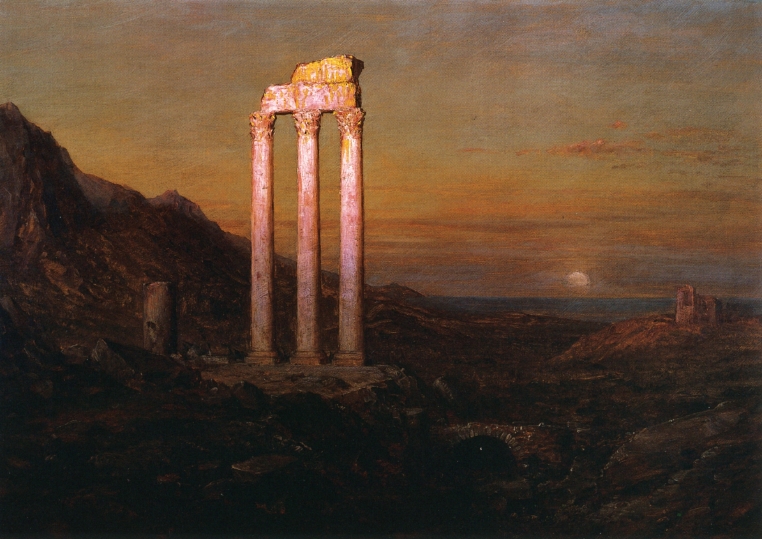We are pleased to feature the following publications and resources that use controlled and innovative perspectives to explore the ancient Greek mytho-poetic tradition as a rich, interconnected system. Taken together, these complimentary works offer a rich and proven critical framework for studying the various layers of meaning in Greek poetry.

“Moonrise,” oil on canvas, by American artist Frederic Edwin Church, 1889. Santa Barbara Museum of Art, Santa Barbara, California. Frederic Edwin Church [Public domain], via Wikimedia Commons
Online Publications
- Leonard Muellner, Classics@ Vol. 3, “Discovery Procedures and Principles for Homeric Research”
Working from Benveniste’s idea that the study of Homeric vocabulary is still in its infancy, Muellner describes a way to do research on Homer and then shows how to work inductively, rebuilding the categories of thought and expression from within the epic world.
We are especially pleased to publish a digital edition of Milman Parry’s doctoral dissertation published in 1928 by Société d’éditions “Les belles lettres” on the use of traditional epithets in Homeric epic.
- Richard Martin, The Language of Heroes: Speech and Performance in the Iliad.
Martin’s central conclusion is that the Iliad takes shape as a poetic composition in precisely the same “speaking culture” that we see foregrounded in the stylized words of the poem’s heroic speakers, especially those speeches designated as muthos, a word the author redefines as “authoritative speech-act.”
- Douglas Frame, The Myth of Return in Early Greek Epic
Through careful analysis, Frame explores the background and use of the Greek root *nes– as found in noos, Nestor and nostos. His insightful analysis shows that *nes– originally had to do with “returning to life and light” and that this meaning can best be understood in the context of solar symbolism.
- Gregory Nagy, Greek Mythology and Poetics
This ground-breaking work explores the Hellenization of the Indo-European system of myth, ritual, poetics and social ideology. The author’s primary aim is to examine the Greek language, by way of comparison with cognate languages, as a reflection of Greek society, with special attention to the function of language as a vehicle of mythology and poetics. Through a collection of individual essays on topics such as the death of Sarpedon and the language of Hesiod, Nagy reveals the powerful Panhellenic forces shaping Greek poetry and the development of the polis.
Homer Multitext Project
The Homer Multitext project, the first of its kind in Homeric studies, presents the textual transmission of the Iliad and Odyssey in a historical framework. It offers free access to a library of texts and images, a machine-interface to that library and its indices, and tools to allow readers to discover and engage with the Homeric tradition. To view the texts use the Manuscript Browser. (We suggest using Firefox or Safari, both freely available.
In addition to creating a multitext edition of the Homeric poems, CHS researchers are working to transcribe, publish, and analyze the scholia assocaited with the text–a varied and rich system streching back to Alexandrian times. One such researcher is HMT editor Casey Dué. Read her latest post on the Homer Multitext blog: “A discovery in the E4 scholia.”
Heroes Course
As part of its educational mission, CHS offers free access to all the resources associated with a distance learning course taught by Center Director Gregory Nagy–including multimedia lectures and discussions, audio recordings, lecture notes, and the complete collection of readings. Concepts of the Hero in Greek Civilization provides an engaging introduction to the major themes of ancient Greek myth, cult and poetics. All readings are in translation and include the epics of Homer, seven tragedies, two Platonic dialogues, and the dialogue On Heroes by Philostratus.
We invite you to learn more about the relationship between past and present in ancient Greek poetics by watching the proseminar discussions on Pindar’s Pythian 8 and Aeschylus’ Seven Against Thebes. The ideas introduced in these videos are examined in greater depth by Nagy in his article “”The Dream of a Shade”: Refractions of Epic Vision in Pindar’s Pythian 8 and Aeschylus’ Seven against Thebes.”
Earthrise. Taken by Apollo 8 crewmember Bill Anders on December 24, 1968.
Available via Wikimedia Commons.
